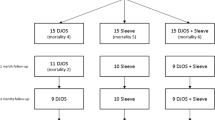Summary
The effect of exogenous insulin treatment on the pancreatic regeneration after major pancreatectomy was evaluated in dogs. More than 92% of the pancreas was removed near the duodenum with the main pancreatic duct left intact. All 26 dogs developed diabetes mellitus (DM) immediately after surgery, and these dogs were divided into two groups: insulin-treated group (n = 19) and noninsulin-treated group (n = 7). All seven dogs in the noninsulin-treated group died within seven weeks after surgery, whereas all dogs in the insulin-treated group survived until the twelfth week, except for six dogs sacrificed on the seventh week, and finally seven (53.8%) of 13 dogs recovered from DM. DNA and polyamine syntheses in the remnant pancreatic tissue at the third day increased more significantly in the insulin-treated group than in the noninsulin-treated group. SigmaIRI inIV-GTT was maintained more significantly in the insulin-treated group, and the regeneration rate at the seventh week was also significantly higher in the insulin-treated group than in the noninsulin treated group. Furthermore, the regeneration rate of the remnant pancreas at seventh week correlated well withDNA synthesis and ornithine decarboxylase activity on the third day. The exogenous insulin treatment after major pancreatectomy enhanced the proliferation of the remnant pancreas within the first week, and it maintained endogenous insulin secretion, promoting pancreatic regeneration.
Similar content being viewed by others
References
Mizumoto R, Yano T, Sekoguchi T, Kawarada Y. Resectability of pancreas without producing diabetes, with special reference to pancreatic regeneration. Intern. J. Pancreatol. 1986; 1: 185–194.
Fujita T. Insulo-acinar portal system in the horse pancreas. Arch. Histol. Jap. 1973; 35: 161–171.
Maekawa S, Hibasami H, Tsukada T, Furusako S, Nakashima K, Yokoyama M. Introductionb of spermidine/spermine N1-acetyltransferase in needle-punctured rat lens as a model of traumatic cataract. Biochem. Biophy. dyActa 1986; 883: 501–505.
Williams JA, Bailey AC, Preissler M, Goldfine ID. Insulin regulation of sugar transport in isolated pancreatic acini from diabetic mice. Diabetes 1982; 31: 674–682.
Korc M, Iwamoto Y, Sankaran H, Williams JA, Goldfine ID. Insulin action in pancreatic acini from streptozotocin-treated rats. I. Stimulation of protein synthesis. Am. J. Physiol. 1981; 240: G56-G62.
Korc M, Owerbach D, Quinto C, Rutter WJ. Pancreatic islet-acinar interaction: amylase messengerRNA levels are determined by insulin. Science 1981; 213: 351–353.
Couture Y, Dunnigan J, Morisset J. Stimulation of pancreatic amylase secretion and protein synthesis by insulin. Scand. J. Gastroenterol. 1972; 7: 257–263.
Logsdon CD. Stimulation of pancreatic acinar cell growth byCCK, epidermal growth factor, and insulin in vitro. Am. J. Physiol. 1986; 251: G487-G494.
Author information
Authors and Affiliations
Rights and permissions
About this article
Cite this article
Ohashi, N., Isaji, S., Kawarada, Y. et al. Effect of insulin treatment on the regeneration of the remnant pancreas after major pancreatectomy in dogs. Int J Pancreatol 9, 165–170 (1991). https://doi.org/10.1007/BF02925593
Issue Date:
DOI: https://doi.org/10.1007/BF02925593




